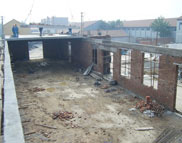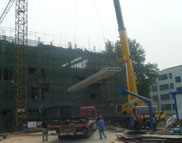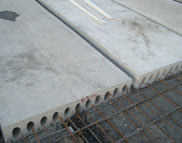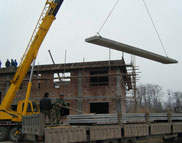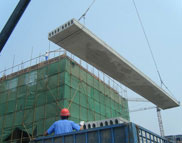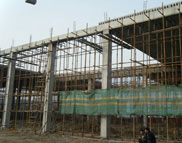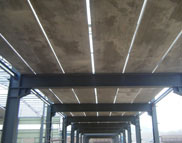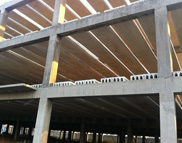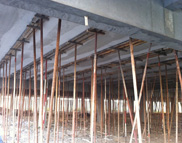Handling and Setting of Hollow core Slab / Plank
Clarify that the site dimensions and details of the Hollow Core Slabs / Planks are in accordance with Shop drawing.
Ensure that bearing surfaces are smooth, flat and level and that they are within ± 6mm in 6 meter.
Be sure that all the other materials that are required for the installation process of the Hollow core are available.
Always provide minimum seven (7) working days delivery notice to the shipper.
Off-loading sequence may differ slightly from the shipping list due to the slab geometry.
Irregular slabs are placed on top of the load.
Prior to unloading, the installer should inspect each shipment.
Any damage not specifically reported on delivery slips and/or not reported to the project engineer becomes the responsibility of the installer.
Stockpiling at the site may be necessary - use full width 4” X 4” dunnage placed on stable level ground. Separate the slab with full width 2” X 4” dunnage.
Keep the dunnage accurately aligned from slab to slab
Balance load to avoid slipping and to eliminate twist on clamps or belts
When using clamps, ensure that the clamp edges fit properly against sound concrete grooves insides of slab, after crane has taken load but before hoisting.
Installation of Hollow core Slab / Plank- Hollow core slabs are to be located and installed in accordance with Approved Shop drawings
- Minimum end bearing is 75mm unless specified otherwise on shop drawings
- Keep slab joint widths uniform
- Blocking for stockpile, same location as lifting
- Refer to shop barcode sticker / drawing for slab weight
- Hoist only one slab at a time.
- Always use safety slings when hoisting with clamps or forks
- never use Hollow core as a platform for hoisting people or materials
- For Hoisting: - Use lifting devices (clamps, belts, chokers, forks) of adequate capacity
- Never hoist slabs by hooking into cores
- Never turn slabs on edge or upside-down with minimum safety factor 5:1
- Clamps should be used only with spreader bar. The slab shall be lifted with lines vertical. If this cannot be accomplished, then belts or chokers should be used instead of clamps.
- On slabs less than 4 feet wide, use belts or chokers; do not use clamps .
- Hand trap - ever put hands in cores or between slabs. Handle only from top surface or with lifting gear.
- For special conditions or concerns of safety, contact Design Engineer before hoisting
Make sure dunnage and pickup point’s line up when plank are being shipped or stacked.
Lift and place plank directly off the truck to avoid unnecessary handling or stockpiling. Plank is delivered with the right side up. Always handle it with this side up.
Make sure slings are located no more than 12-inches from the ends when lifting plank. Never lift hollow core plank from the middle with a single sling!
Never cantilever or overhang plank unless it has been designed for such an application.
Minimum bearing should be as per approved shop drawings. Place bearing strips in accordance with the shop drawings.
Set each plank as close as possible to its final position, allowing just enough room to remove the slings. After removing slings, skid the plank in final position against the adjacent one.
Split or saw plank to obtain special widths as shown on the shop drawings.
Be sure that the slabs are set squarely. Make connections carefully. Bend or place bars and/or weld per the approved shop drawings and construction documents.
Leveling and Grouting Hollow core Plank
Prior to grouting the keyways, any variations between adjacent slabs should be reasonably levelled out by jacking.
Clear debris from keyways. Wet down the keyways prior to grouting to insure a good bond. This is especially important in hot weather.
Place grout in keyways using a 3:1 mixture of three parts sand to one part cement. Grout should be wet enough to flow easily to assure complete filling of keyways.
Clean the underside of the plank to remove any grout that might have seeped through if necessary.
Make sure grout has cured prior to placing heavy loads on the plank surface. (Construction materials, etc.)
Hollow core planks should be designed to support the applied loads with the size and location of the openings that are shown on the shop drawings. Do not cut openings that are not shown.
If necessary, obtain written permission from design engineer before core drilling additional openings that are not shown on the approved shop drawings.
Openings should not be cut until the joints are grouted and the grout has achieved 85% of its design strength (the design strength of grout is typically 3,000 psi).
When concrete topping is required, the plank must be grouted first. The hollow core deck surface must be clean and thoroughly damp with no standing water, unless otherwise specified. Clean the hollow core surface of all laitance.
Various Installation details for Hollow Core Slab / Plank

Figure 1 - End Bearing On Block - Half Bearing - Tie Up (Scale - N.T.S.)







